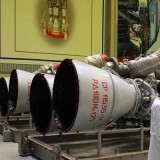Belgium Prepares Future of Its Air Defense with Two Newly Delivered F-35 Fighter Jets

{loadposition bannertop}
{loadposition sidebarpub}
The ongoing delivery of F-35 fighter jets to Belgium is steadily advancing, reinforcing the modernization of the Air & Space Component. As reported by A L’avant Garde, the arrival of two additional aircraft brings the Belgian fleet to seven units currently based in the United States for pilot training. This number is set to increase further in the coming days with the delivery of an eighth aircraft, completing the initial batch planned under Belgium’s acquisition of this advanced fifth-generation stealth fighter.
Follow Army Recognition on Google News at this link
Designed for a broad spectrum of missions, including air superiority, precision strikes, intelligence gathering, and electronic warfare, the F-35 is equipped with state-of-the-art sensors that enhance its operational effectiveness. (Picture source: US Air Force)
These F-35s are temporarily stationed at Luke Air Force Base in Arizona, a key training hub where Belgian pilots and maintenance crews undergo intensive operational preparation. This phase is crucial for ensuring a seamless transition from the aging F-16 fleet to the more technologically advanced F-35. The first units intended for deployment on Belgian soil are scheduled to arrive at Florennes Air Base in autumn 2025, marking a major step toward the aircraft’s operational integration. Meanwhile, the ninth aircraft has already entered the assembly phase, further advancing the gradual introduction of these fighter jets.
The F-35A Lightning II, developed by Lockheed Martin, represents a new era in combat aviation, integrating stealth capabilities, cutting-edge avionics, and networked warfare features. Designed for a broad spectrum of missions, including air superiority, precision strikes, intelligence gathering, and electronic warfare, the F-35 is equipped with state-of-the-art sensors that enhance its operational effectiveness. These include the AN/APG-81 AESA radar, capable of tracking multiple airborne and ground targets with precision; the Electro-Optical Targeting System (EOTS), which enhances target acquisition and tracking; and the Distributed Aperture System (DAS), which provides a 360-degree situational awareness capability, giving pilots an unprecedented level of visibility and threat detection.
The aircraft’s propulsion system, the Pratt & Whitney F135-PW-100 engine, delivers 43,000 pounds of thrust with afterburner, enabling the F-35 to reach speeds of Mach 1.6 while maintaining a low radar signature. This combination of speed, stealth, and sensor fusion makes it a formidable asset in both contested and permissive environments.
In terms of armament, the F-35A features an internal M61A2 Vulcan 20mm cannon for close-range engagements and is designed to carry a versatile array of munitions. For air-to-air combat, it can be armed with AIM-120 AMRAAM and AIM-9X Sidewinder missiles, ensuring it remains lethal in dogfights and beyond-visual-range engagements. For air-to-ground operations, it can deploy precision-guided munitions such as the GBU-31 JDAM, GBU-39 Small Diameter Bomb (SDB), and the AGM-88 HARM, making it highly effective against enemy infrastructure and air defense systems. Its electronic warfare suite includes sophisticated countermeasures and jamming capabilities, increasing its survivability against advanced air defense threats. The aircraft’s network-centric design allows real-time data exchange with allied forces, enhancing coordination in multinational operations.
To accommodate the arrival of the F-35, Belgium has undertaken significant infrastructure upgrades at the Florennes and Kleine-Brogel air bases. These modifications include the construction of specialized hangars, maintenance facilities, and security installations adapted to the aircraft’s operational needs. The Florennes base is expected to be fully ready for F-35 operations by 2025, while Kleine-Brogel will follow in 2027. These infrastructure investments ensure that Belgium can fully exploit the capabilities of its new fleet while maintaining interoperability with NATO allies.
The introduction of the F-35 into the Belgian Air Force marks a pivotal shift in national defense strategy, bringing an aircraft with advanced stealth, networked warfare, and precision strike capabilities. With its ability to seamlessly integrate into NATO’s collective defense framework, the F-35 will play a critical role in Belgium’s national security posture. The transition from F-16 to F-35 is expected to be completed by 2028, ensuring that Belgium maintains a credible air deterrence capability while continuing to contribute to international security operations.

{loadposition bannertop}
{loadposition sidebarpub}
The ongoing delivery of F-35 fighter jets to Belgium is steadily advancing, reinforcing the modernization of the Air & Space Component. As reported by A L’avant Garde, the arrival of two additional aircraft brings the Belgian fleet to seven units currently based in the United States for pilot training. This number is set to increase further in the coming days with the delivery of an eighth aircraft, completing the initial batch planned under Belgium’s acquisition of this advanced fifth-generation stealth fighter.
Designed for a broad spectrum of missions, including air superiority, precision strikes, intelligence gathering, and electronic warfare, the F-35 is equipped with state-of-the-art sensors that enhance its operational effectiveness. (Picture source: US Air Force)
These F-35s are temporarily stationed at Luke Air Force Base in Arizona, a key training hub where Belgian pilots and maintenance crews undergo intensive operational preparation. This phase is crucial for ensuring a seamless transition from the aging F-16 fleet to the more technologically advanced F-35. The first units intended for deployment on Belgian soil are scheduled to arrive at Florennes Air Base in autumn 2025, marking a major step toward the aircraft’s operational integration. Meanwhile, the ninth aircraft has already entered the assembly phase, further advancing the gradual introduction of these fighter jets.
The F-35A Lightning II, developed by Lockheed Martin, represents a new era in combat aviation, integrating stealth capabilities, cutting-edge avionics, and networked warfare features. Designed for a broad spectrum of missions, including air superiority, precision strikes, intelligence gathering, and electronic warfare, the F-35 is equipped with state-of-the-art sensors that enhance its operational effectiveness. These include the AN/APG-81 AESA radar, capable of tracking multiple airborne and ground targets with precision; the Electro-Optical Targeting System (EOTS), which enhances target acquisition and tracking; and the Distributed Aperture System (DAS), which provides a 360-degree situational awareness capability, giving pilots an unprecedented level of visibility and threat detection.
The aircraft’s propulsion system, the Pratt & Whitney F135-PW-100 engine, delivers 43,000 pounds of thrust with afterburner, enabling the F-35 to reach speeds of Mach 1.6 while maintaining a low radar signature. This combination of speed, stealth, and sensor fusion makes it a formidable asset in both contested and permissive environments.
In terms of armament, the F-35A features an internal M61A2 Vulcan 20mm cannon for close-range engagements and is designed to carry a versatile array of munitions. For air-to-air combat, it can be armed with AIM-120 AMRAAM and AIM-9X Sidewinder missiles, ensuring it remains lethal in dogfights and beyond-visual-range engagements. For air-to-ground operations, it can deploy precision-guided munitions such as the GBU-31 JDAM, GBU-39 Small Diameter Bomb (SDB), and the AGM-88 HARM, making it highly effective against enemy infrastructure and air defense systems. Its electronic warfare suite includes sophisticated countermeasures and jamming capabilities, increasing its survivability against advanced air defense threats. The aircraft’s network-centric design allows real-time data exchange with allied forces, enhancing coordination in multinational operations.
To accommodate the arrival of the F-35, Belgium has undertaken significant infrastructure upgrades at the Florennes and Kleine-Brogel air bases. These modifications include the construction of specialized hangars, maintenance facilities, and security installations adapted to the aircraft’s operational needs. The Florennes base is expected to be fully ready for F-35 operations by 2025, while Kleine-Brogel will follow in 2027. These infrastructure investments ensure that Belgium can fully exploit the capabilities of its new fleet while maintaining interoperability with NATO allies.
The introduction of the F-35 into the Belgian Air Force marks a pivotal shift in national defense strategy, bringing an aircraft with advanced stealth, networked warfare, and precision strike capabilities. With its ability to seamlessly integrate into NATO’s collective defense framework, the F-35 will play a critical role in Belgium’s national security posture. The transition from F-16 to F-35 is expected to be completed by 2028, ensuring that Belgium maintains a credible air deterrence capability while continuing to contribute to international security operations.




